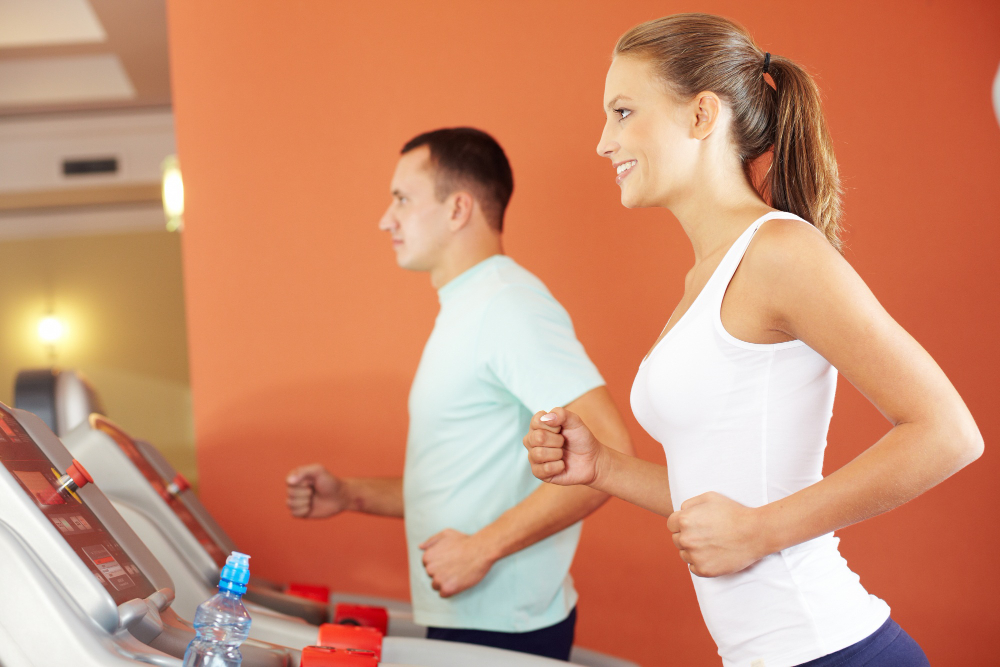The Department of Health recommends a minimum of 150 minutes of moderate exercise per week. Migration is a popular choice; it is available, inexpensive, provides good strength training, and requires no further adjustments. Walking on a treadmill is like walking outdoors, which has both physical and practical benefits.
Benefits of Treadmill Walking
Strength and muscle tone
Regular exercise on a treadmill will maintain a healthy musculoskeletal system which includes muscles, bones, ligaments, tendons and joints. As a heavy exercise, the treadmill pulls the bones to prevent age-related bone loss. Walking also strengthens the muscles of the legs and buttocks. The strengthening effect of the legs improves if the treadmill is moved into an inclined position.
Joint flexibility
Moderate-intensity exercises, such as walking, keep the joints flexible. This is especially important in arthritis. Instead of walking on a road bike, the treadmill walking has the added benefit of reducing stress on the knee, knee and hip joints as the waistband and belt make the groin softer. This shock absorbing ability allows you to walk with less pressure on your joints than you would normally do in outdoor passages. Thread milling cutters can increase the chance of joint damage due to uneven, usually external, surfaces.
Cardiovascular gymnastics
Running fast on a treadmill can improve cardiovascular health, strengthen the heart, and lower blood pressure. Walking on Treadmill regularly helps lower cholesterol, reducing the risk of heart attack and stroke. Some treadmill models are equipped with a heart rate monitor that helps you optimize your cardiovascular performance.
Reduced risk of disease
Traditional treadmill can reduce the risk of type II diabetes, prediabetes, degenerative arthritis, hypertension, depression, insomnia, and breast and colon cancer. Walk at least 150 minutes a week on the treadmill or other moderate-intensity exercise to reduce the risk of premature death.
Weight control
Running on or off the treadmill helps control weight by burning excess calories and keeping your metabolism active. Many treadmills have a calorie counter that estimates the number of calories burned during exercise. This information will help you plan your diet, especially when you are trying to lose weight.
Read Also: 5 Working Tips for Beginners to Exercise Consistently
Simple
By walking on a treadmill instead of going out, you avoid some of the inconveniences that may prevent you from exercising regularly. You don’t have to worry about the weather or the air quality in the room, which is an important aspect of asthma or seasonal allergies. With a home group, you can enjoy the freedom to practice whenever you want. When multitasking, reading, running problems or other activities while the treadmill is stable.
To Make the Walking Exercise Easier
Losing weight is an ambitious goal that many people achieve. The two most important factors in achieving your weight loss goals are calorie reduction and fitness. Whether you need to lose 10 pounds or 100 pounds, aerobic exercise will add calories, improve blood circulation, increase lung capacity, and improve mood. While being in the gym is always an option, the Mayo Clinic recommends a quieter way to lose weight and improve your health. Walking is the only aerobic exercise that is easy to plan for a busy day.
Burn Calories
Before starting a walking routine, it is helpful to know how many calories you will gain from moderate to low strength training such as weight training. B. To walk, to be able to burn. To lose half a pound, you need to burn 3,500 calories. A calorie reduction of 500 calories per day equals 3,500 calories per week, which means losing an average weight of 1 pound per week. If you walk vigorously for 45-60 minutes per day, you can burn 200 to 460 extra calories per day, depending on your weight and walking speed.
Break it
Building a walking routine that fits your lifestyle and work schedule is critical to the success of your fitness and weight loss program. According to the University of Maryland Medical Center, daily walks can be divided into shorter walks of 10 to 15 minutes. Therefore, a 15-minute walk during breaks and lunch is one way to reach your aerobic goals for the day. If you are losing a lot of weight, taking a break from walking during the day can reduce the overall stress on your body and temporarily reduce your appetite.
Find a Partner
There are good reasons that motivate many jobs to run programs. A walking routine encourages you to take frequent breaks and you are responsible not only for yourself but also for your walking companions. Maintaining a regular routine will improve your cardiovascular health and help you lose weight, making it an asset to you, your colleagues and your workplace. Even single parents or parents at home can plan field trips with their partner, friends or neighbors to do the 300-minute relaxation exercise recommended by the Mayo Clinic.
Weather Restrictions
When the weather is bad, a visit to an air conditioning center or a treadmill at the gym is a viable option. Whether at 100 degrees F or 20 degrees when it snows, at home or on vacation, the migration is easy to adapt to current conditions. With a free app on a smartphone or inexpensive pedometer, you can track your daily progress, including mileage and daily calorie consumption.
Benefits of walking and exercising three days a week
You don’t have to be a fitness physiologist to understand that the human body is there to move. More than just a benefit to the human body, physical activity is an integral part of your good health. Exercising three or more days a week will bring you person-to-foot benefits as an adult, improve your quality of life, and extend your life.
Healthy Muscles and Bones
“Use or release” literally applies to your muscles. A sedentary lifestyle contributes to muscle contraction or atrophy. Walking and other sports will help you maintain adequate muscle mass. This stimulating fitness benefit is especially important in mid-to-late adults, when muscle mass and strength usually decrease. If you include strength training or weight lifting in your fitness regimen at least twice a week, you can maintain muscle strength. Your bones will also benefit from walking and weight training. When you walk, your back and legs support the weight of your body. Carrying weights strengthens bones and helps prevent osteoporosis. Intensive training two or more days a week increases this bone building effect.
Cardiovascular Gymnastics
Walking can improve your cardiovascular fitness and reduce the risk of heart attacks and strokes. (Ref. 5) To receive these benefits, your speed must be fast enough to raise your heart rate from approximately 65 to 80 percent of your maximum heart rate. Use the “voice test” to find out if your heart rate is within this range. Walk fast enough to breathe and sweat more, but not so fast that you can’t speak. If you can recite the lyrics of your favorite song out loud but can’t sing it, you are in the right rhythm for the cardiovascular benefits. Walk at this pace for at least 150 minutes a week to make sure your heart benefits from your fitness regimen. A session you go to three days a week.
Weight control
Walking calories and other sports burn calories, which will help you manage your weight. The speed, weight, and duration of your goose sessions will affect the number of calories you burn. For example, a 160-pound man or 160-pound woman typically burns about 205 calories per hour at 2 miles per hour and 315 calories at 3.5 miles per hour. Using muscles while walking or exercising also helps maintain metabolism, another important factor in keeping body weight within a healthy range.
Improvement of General Health
Physical activity improves overall health by reducing the risk of diseases and potential illnesses.




